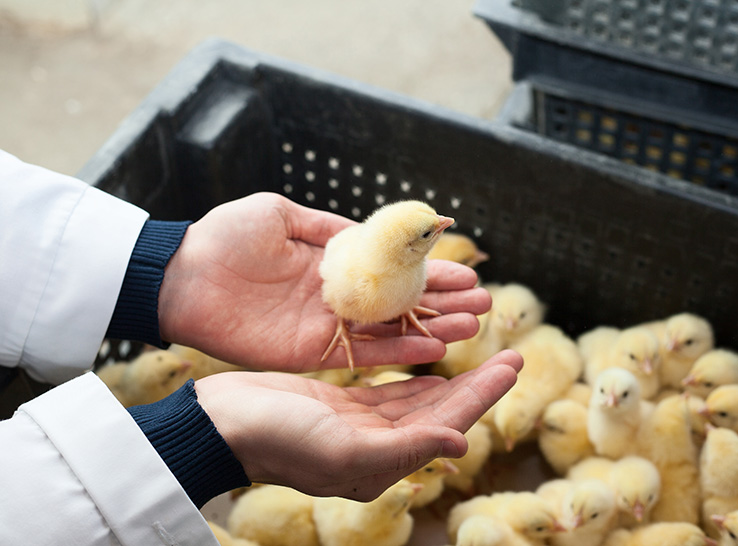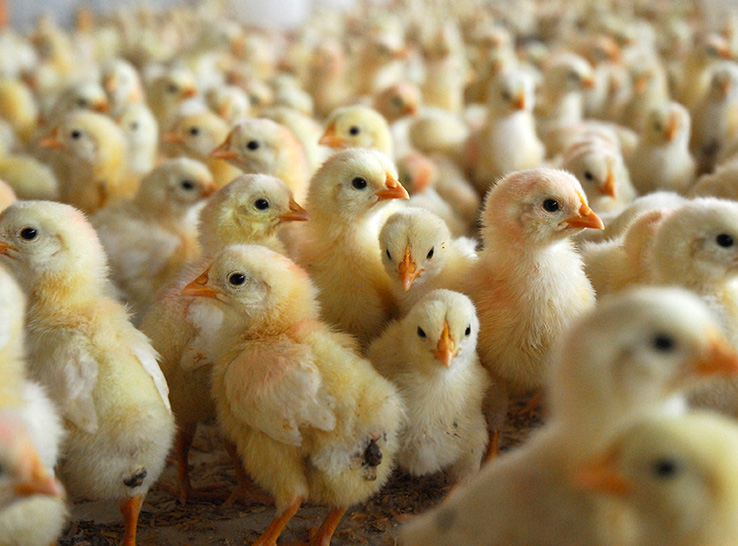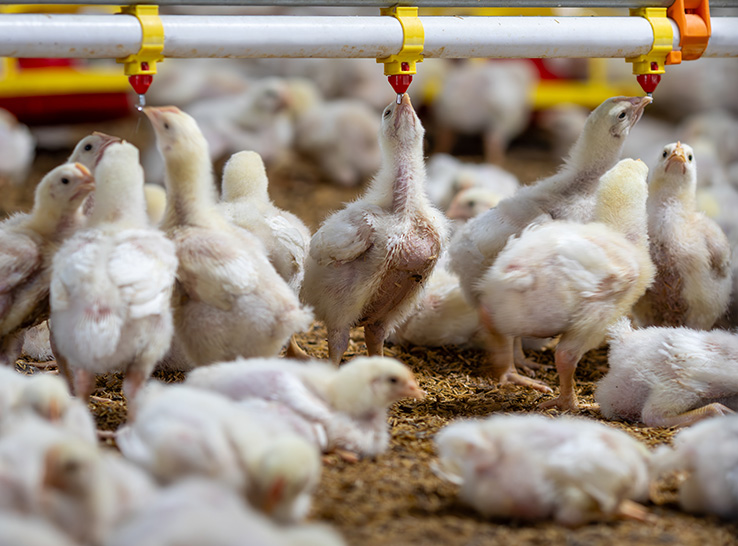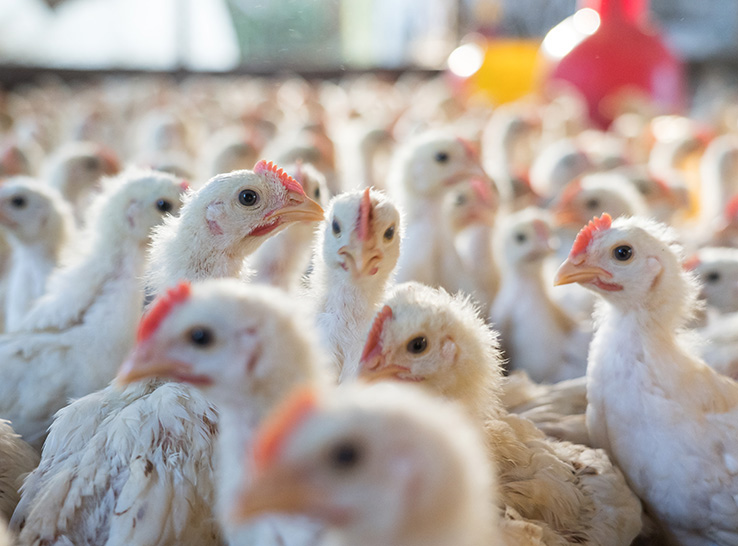By Nabin Neupane, University of Georgia and Dr. Prafulla Regmi, University of Georgia
Human-animal interaction is the mutual and dynamic relationship between a human and an animal where the animal perceives human interaction as degree of relatedness or distance and vice-versa. Human beings have domesticated poultry species for eggs and meat production. Domestication has favored tameness in animals, however, fearfulness as a trait still persists and domestic animals often perceive human encounters as fearful.
Human-animal interactions (HAI) occur in different contexts during routine husbandry practices, veterinary treatment, or during restraint (sampling, weighing, catching, loading, unloading). The nature of the interactions between animals and humans can be positive, negative or neutral. In positive interactions, animals do not experience fear and do not show avoidance when humans approach them. If the interaction is negative, the animal exhibits fear associated behavior and will avoid humans. Negative human-animal interactions have adverse effects on animal health and welfare. In this newsletter we will discuss how the quality of the HAI can impact poultry production and welfare and approaches to reinforce positive HAI among stockpeople.
Fear and stress: Physiological mechanisms
Chickens in commercial production are challenged with various environmental (heat, cold, lighting, bedding material) and management-related (feed restriction, high stocking density, anticipation for food) stressors. Animals show behavioral changes in response to these stressful insults. However, if animals fail to cope with the stressors through behavioral change, endocrine and neuro-endocrine systems within the animal’s body continue to respond to the stressors. During acute stress, the neuroendocrine system activates the fight, flight or fright response. If the quality of the HAI is poor, prolonged, and inevitable, animals can suffer from chronic stress. During chronic stress, endocrine system is activated, resulting in production of corticosterone. Corticosterone influences the immune system, growth, and behavior in animals.
Assessment of HAI
Animals express fear-related behaviors such as withdrawal from humans. In some instances animals can also exhibit complete immobility or freezing and even though animals seem calm, they are experiencing extreme fear. The quality of HAI can be measured by the avoidance distance test (ADT). This test can be conducted in commercial broiler operations by recording the withdrawal response of the chickens as the experimenter walks slowly through the length of the house. Several studies have found that fear of animals towards humans can affect flock productivity, reproductive efficiency, and health.
Impact of HAI on poultry performance and health
Animal production
- Broilers under chronic stress are known to have decreased weight gain and decreased feed efficiency.
- Laying hens with regular visual contact with humans exhibited reduced avoidance behavior and improved egg production.
- A negative HAI can reduce reproduction in some animals. For example, unpleasant handling of pigs can lead to lower pregnancy rates in sows and reduced testicle size and delayed mating responses in males.
Animal health
- Negative handling impairs the immune response through production of immunosuppressive hormones such as catecholamines and corticosterone.
- A lower antibody response to New-Castle disease was reported in broilers without any provision of visual contact with humans compared to broilers provided with visual human contact from an early age indicating a poor immune response in the former.
Attitude and behavior of stockpeople
The quality of HAI is greatly influenced by the attitude and behavior of people working with animals. In farm settings, humans handle the animals based on the experience they learnt themselves or from other humans; animals perceive these interactions as positive, negative or neutral. The stockperson should understand the behavior of animals they are working with. If an animal is difficult to restrain, and escapes and injures the stockperson, then the person will have negative response towards animals. On the other hand, if a person doesn’t understand the proper method of animal handling, their actions induce stress to the animal and perpetuates its fear response. The bi-directional nature of the human-animal relationship is highlighted in the figure below.
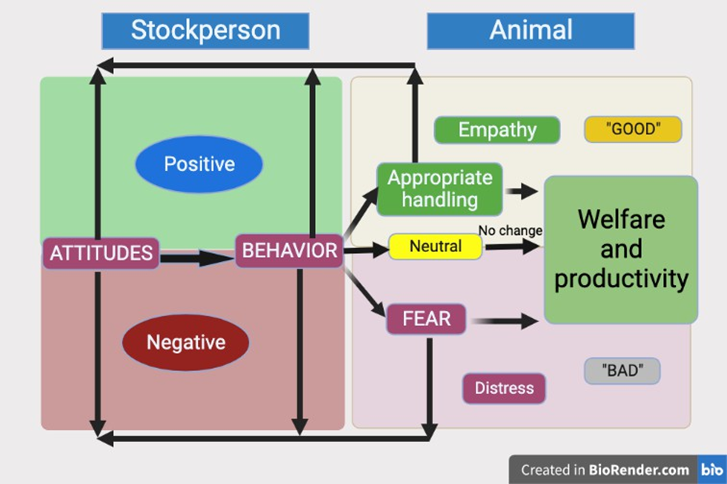
Human animal interaction model originally proposed by Hemsworth & Coleman (1998) and adapted from Martinez et al., 2019.
Cognitive behavioral training for stockpeople
Cognitive behavioral training, which basically attempts to change the way people think, is an applied training process that can improve the stockperson’s behavior towards animals. It involves providing knowledge and skills on animal handling to the stockpeople and motivating them to have positive beliefs and habits towards animals. Some essential topics that stockpeople should understand are normal and abnormal behaviors of the animal, methods to identify those behaviors, appropriate ways to approach and handle the animals and the consequences of improper handling. Training followed by a questionnaire predicting the stockperson’s attitude and behavior can be used to select prospective employees at the farm.
Positive HAI
Positive attitudes and behavior towards animals by human beings will create favorable HAI, which ultimately will improve animal productivity and welfare. The animal uses the energy to carry out body functions like growth, reproduction and health. During stressful conditions, the body uses greater energy to cope with stress and, as a result, resources available for production are reduced. In contrast, positive HAI leads to proportionate distribution of energy towards production and health.
Some benefits of positive HAI are:
- Fear response – Poultry can become less fearful towards human with gentle handling on a regular basis.
- Production performance – Improvement in body weight gain and feed efficiency.
- Immunity – Increased immune response against viral disease in broilers provided with regular visual human contact.
- Public health – Frequent positive interactions with backyard chickens was associated with low Salmonella prevalence in those flocks. However, a direct cause-effect relationship has not been established.
Conclusion
- Human-animal interactions can be positive, negative, or neutral based on animal’s experience.
- Negative HAI induces fear and stress in animals which can adversely affect their health, reproduction, productivity, and welfare.
- Attitude and behavior of stockperson towards proper animal handling can be achieved through cognitive behavioral training.
To view the full Poultry Extension Collaborative newsletter, vol 34, click here.
Editor’s note: Content on Modern Poultry’s Industry Insights pages is provided and/or commissioned by our sponsors, who assume full responsibility for its accuracy and compliance.

